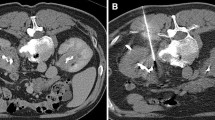Abstract
Purpose
To evaluate the indications, technique, results, and complications of image-guided percutaneous biopsy of the urinary bladder.
Methods
This retrospective study included 15 patients (10 male, 5 female) who underwent image-guided percutaneous biopsy of the urinary bladder between January 1999 and December 2013. The medical records, imaging studies, procedural details, and long-term follow-up of each patient were reviewed in detail to assess the feasibility of percutaneous bladder biopsy.
Results
Ten patients had focal bladder masses and 5 patients had asymmetric or diffuse bladder wall thickening. Eleven patients had either negative or unsatisfactory cystoscopies prior to the biopsy. Percutaneous biopsies were performed under computed tomography guidance in 12 patients and ultrasound in 3 patients. All procedures were technically successful and there were no procedural complications. Malignancy was confirmed in 8 patients, among whom 6 had transitional cell carcinoma, 1 cervical cancer, and 1 prostate cancer metastasis. Seven patients had a benign diagnosis, including 3 that were later confirmed by pathology following surgery and 2 patients with a false-negative result. The overall sensitivity was 80% and accuracy was 87%.
Conclusions
Image-guided percutaneous biopsy of the urinary bladder is a safe and technically feasible procedure with a high sensitivity and accuracy rate. Although image-guided bladder biopsy is an uncommon procedure, it should be considered in selected cases when more traditional methods of tissue sampling are either not possible or fail to identify abnormalities detected by cross-sectional imaging.


Similar content being viewed by others
References
Siegel R, et al. (2014) Cancer statistics, 2014. CA Cancer J Clin 64(1):9–29
Kaufman DS, Shipley WU, Feldman AS (2009) Bladder cancer. Lancet 374(9685):239–249
Grasso M, et al. (1993) Actively deflectable, flexible cystoscopes: no longer solely a diagnostic instrument. J Endourol 7(6):527–530
Burke DM, Shackley DC, O’Reilly PH (2002) The community-based morbidity of flexible cystoscopy. BJU Int 89(4):347–349
Lotan Y, Roehrborn CG (2003) Sensitivity and specificity of commonly available bladder tumor markers versus cytology: results of a comprehensive literature review and meta-analyses. Urology 61(1):109–118 (discussion 118)
Herr HW (1996) Routine CT scan in cystectomy patients: does it change management? Urology 47(3):324–325
Fielding JR, et al. (2002) Tumor detection by virtual cystoscopy with color mapping of bladder wall thickness. J Urol 167(2 Pt 1):559–562
Walker L, Liston TG, Liston TG, LLoyd-Davies RW (1993) Does flexible cystoscopy miss more tumours than rod-lens examination? Br J Urol 72(4):449–450
Tsili A, et al. (2004) Computed tomographic virtual cystoscopy for the detection of urinary bladder neoplasms. Eur Urol 46(5):579–585
Gupta S, et al. (2003) CT-guided needle biopsy of deep pelvic lesions by extraperitoneal approach through iliopsoas muscle. Cardiovasc Intervent Radiol 26(6):534–538
Gupta S, et al. (2004) Various approaches for CT-guided percutaneous biopsy of deep pelvic lesions: anatomic and technical considerations. Radiographics 24(1):175–189
Patel IJ, et al. (2012) Consensus guidelines for periprocedural management of coagulation status and hemostasis risk in percutaneous image-guided interventions. J Vasc Interv Radiol 23(6):727–736
Venkatesan AM, et al. (2010) Practice guidelines for adult antibiotic prophylaxis during vascular and interventional radiology procedures. Written by the Standards of Practice Committee for the Society of Interventional Radiology and Endorsed by the Cardiovascular Interventional Radiological Society of Europe and Canadian Interventional Radiology Association [corrected]. J Vasc Interv Radiol 21(11):1611–1630 (quiz 1631)
Grossfeld GD, et al. (2001) Evaluation of asymptomatic microscopic hematuria in adults: the American Urological Association best practice policy–part II: patient evaluation, cytology, voided markers, imaging, cystoscopy, nephrology evaluation, and follow-up. Urology 57(4):604–610
Grossfeld GD, et al. (2001) Asymptomatic microscopic hematuria in adults: summary of the AUA best practice policy recommendations. Am Fam Physician 63(6):1145–1154
Soloway MS, et al. (1978) Serial multiple-site biopsies in patients with bladder cancer. J Urol 120(1):57–59
Jocham D, Stepp H, Waidelich R (2008) Photodynamic diagnosis in urology: state-of-the-art. Eur Urol 53(6):1138–1148
Gani MS, Shafee AM, Soliman IY (2011) Ultrasound guided percutaneous fine needle aspiration biopsy/automated needle core biopsy of abdominal lesions: effect on management and cost effectiveness. Ann Afr Med 10(2):133–138
Babjuk M, et al. (2013) EAU guidelines on non-muscle-invasive urothelial carcinoma of the bladder: update 2013. Eur Urol 64(4):639–653
Conflict of interest
None of the contributing authors have any conflicts of interest, including specific financial interests or relationships and affiliations relevant to the subject matter or materials discussed in the manuscript.
Author information
Authors and Affiliations
Corresponding author
Rights and permissions
About this article
Cite this article
Butros, S.R., McCarthy, C.J., Karaosmanoğlu, A.D. et al. Feasibility and effectiveness of image-guided percutaneous biopsy of the urinary bladder. Abdom Imaging 40, 1838–1842 (2015). https://doi.org/10.1007/s00261-015-0356-5
Published:
Issue Date:
DOI: https://doi.org/10.1007/s00261-015-0356-5




